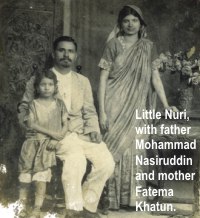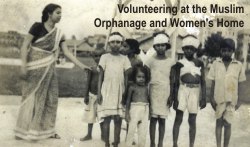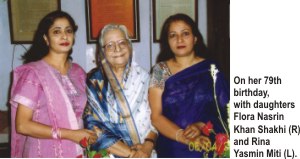|
Cover
Story
 LEADING
WOMEN TO CHANGE LEADING
WOMEN TO CHANGE
On the
occasion of International Women's Day, SWM pays tribute to
a living legend in journalism and a pioneer in making women
visible.
Nurjahan
Begum, editor of Begum magazine, began her career in the 1940s.
Journalism, activism, social work -- she has done it all,
and in a time people would have trouble imagining women doing
anything of the sort. To this day, she continues to help women
in towns and villages find a foothold in society through her
efforts to provide them with knowledge, a sense of awareness
and even identities as women writers, .
She goes to work every morning at 8 and returns home every
afternoon to her sprawling house in Puran Dhaka -- her home
since 1950 -- and continues the work she and her father started
decades ago. It is not an empire she manages now, but it has
served, for well over half a century, the purpose with which
it was begun -- to bring Bangali, especially Bangali Muslim
women, out from behind the closed walls of their homes and
into the wider, changing society of which they are part.
KAJALIE
SHEHREEN ISLAM
 Nurjahan Begum
was born on June 4, 1925, as Nurun Nahar. Her father, renowned
journalist and editor of the monthly Shawgat, Mohammad
Nasiruddin, lived in Kolkata, while she, "Nuri",
lived with her mother, Fatema Begum, in Chalitatoli. After
an accident in which Nuri fell into a pond in the village
at the age of four, her father quickly had her move to Kolkata
with her mother, thinking his daughter would be far safer
there. Nurjahan Begum
was born on June 4, 1925, as Nurun Nahar. Her father, renowned
journalist and editor of the monthly Shawgat, Mohammad
Nasiruddin, lived in Kolkata, while she, "Nuri",
lived with her mother, Fatema Begum, in Chalitatoli. After
an accident in which Nuri fell into a pond in the village
at the age of four, her father quickly had her move to Kolkata
with her mother, thinking his daughter would be far safer
there.
"When
I came to Kolkata," reminisces Nurjahan Begum, "my
father, to the utter dismay of my mother, had my nose-pin
cut off and my hair sheared into a 'China bob' cut!"
 Mohammad
Nasiruddin was a progressive man and he wanted his daughter
to be the same, easily fitting into Kolkata society and making
something of herself with a good, well-rounded education.
Little Nuri was taught nursery rhymes, poems and surahs
by her mother, and the Bangla, Arabic and English alphabet
by both her parents. Her father would bring home books and
magazines for Nuri to go through and look at pictures. Slowly,
she grew an interest in books. Even before she had learnt
to read properly, Nuri began to file her father's collection
of local and foreign publications just by looking at the pictures.
Delighted by her keen intelligence, Nuri's grandmother, Nurjahan,
decided to name her granddaughter after herself, and, from
then on, she became Nurjahan Begum. Mohammad
Nasiruddin was a progressive man and he wanted his daughter
to be the same, easily fitting into Kolkata society and making
something of herself with a good, well-rounded education.
Little Nuri was taught nursery rhymes, poems and surahs
by her mother, and the Bangla, Arabic and English alphabet
by both her parents. Her father would bring home books and
magazines for Nuri to go through and look at pictures. Slowly,
she grew an interest in books. Even before she had learnt
to read properly, Nuri began to file her father's collection
of local and foreign publications just by looking at the pictures.
Delighted by her keen intelligence, Nuri's grandmother, Nurjahan,
decided to name her granddaughter after herself, and, from
then on, she became Nurjahan Begum.
 Nurjahan
Begum got admitted into Baby Class at Begum Rokeya's Sakhawat
Memorial School. She loved it there -- the playing, drawing,
arts and crafts. But when the workload got to be a little
too much after Class 2, her father shifted her to a school
near their home, Beltola Girl's School. In Class 5, however,
she went back to Sakhawat Memorial School from which she passed
her Matriculation in 1942. Nurjahan Begum remembers the school
fondly as the basis of her success later on in life. She had
the opportunity to learn to do a bit of everything there,
from singing, dancing and acting to cooking, sewing, drawing
and sports. In 1944, she passed her Intermediate examinations
in philosophy, history and geography, and, in 1946, her Bachelors
in ethics, philosophy and history from Lady Brabourne College. Nurjahan
Begum got admitted into Baby Class at Begum Rokeya's Sakhawat
Memorial School. She loved it there -- the playing, drawing,
arts and crafts. But when the workload got to be a little
too much after Class 2, her father shifted her to a school
near their home, Beltola Girl's School. In Class 5, however,
she went back to Sakhawat Memorial School from which she passed
her Matriculation in 1942. Nurjahan Begum remembers the school
fondly as the basis of her success later on in life. She had
the opportunity to learn to do a bit of everything there,
from singing, dancing and acting to cooking, sewing, drawing
and sports. In 1944, she passed her Intermediate examinations
in philosophy, history and geography, and, in 1946, her Bachelors
in ethics, philosophy and history from Lady Brabourne College.
 Nurjahan
Begum was highly active throughout her school and college
life. "I had a wonderful childhood," she says. "We
did everything, from singing and dancing to acting."
She even wrote, directed and acted in college plays. "But
it was all within the walls of the school and college,"
she recalls. Nurjahan
Begum was highly active throughout her school and college
life. "I had a wonderful childhood," she says. "We
did everything, from singing and dancing to acting."
She even wrote, directed and acted in college plays. "But
it was all within the walls of the school and college,"
she recalls.
Most
Bangali and especially Muslim women of the time hardly stepped
out of the house, let alone sing and dance in public places.
The volatile days of 1947 had made it even more dangerous
for people living in this region.
"It
was under these circumstances," says Nurjahan Begum,
"that Begum was first published."
Nurjahan
Begum's father, Mohammad Nasiruddin, had wanted to bring women
into journalism. He therefore started an annual women's issue
of Shawgat in 1927. Every year, one issue of the
monthly would be dedicated exclusively to women, with writings
by women around the country that Mohammad Nasiruddin had to
put in much effort to collect. In 1945, the last issue of
Janana Mahal, came out. It seemed to Mohammad Nasiruddin
that one women's issue per year was not really doing much
to improve the situation of women in journalism and, in turn,
society. Thus, in 1947, a month before India's Partition,
weekly Begum was first published in Kolkata. Its
first editor was Begum Sufia Kamal, and acting editor, Nurjahan
Begum, who had already been working for Shawgat,
took over a few months later.
 "It
was very difficult to bring out the publication at that time,"
recalls Nurjahan Begum. There was the problem of block and
type, of collecting ink and paper, and of transporting the
staff to and from the office during the communal riots. There
were not too many women writers and hardly any women photographers.
"But we still managed to bring out an issue every week,"
says Nurjahan Begum proudly. "It
was very difficult to bring out the publication at that time,"
recalls Nurjahan Begum. There was the problem of block and
type, of collecting ink and paper, and of transporting the
staff to and from the office during the communal riots. There
were not too many women writers and hardly any women photographers.
"But we still managed to bring out an issue every week,"
says Nurjahan Begum proudly.
After
three years in Kolkata, Begum moved to Dhaka, along
with Mohammad Nasiruddin, Nurjahan Begum and the rest of the
family.
 The
response to Begum was enormous. Not only were women
from across the country writing letters and giving feedback
on the various writings published in the magazine, but many
men, Nurjahan Begum also reminisces about her father and her
husband, the two men who had the greatest influence on her
life and her success in her career. Her father was the one
to lead her down the path of journalism, though Nurjahan Begum
believes that passion for journalism -- or any profession
for that matter -- is inborn. "It cannot be forced upon
you," she says. All her life, she has simply done what
she always wanted to and what she felt she was meant to do. The
response to Begum was enormous. Not only were women
from across the country writing letters and giving feedback
on the various writings published in the magazine, but many
men, Nurjahan Begum also reminisces about her father and her
husband, the two men who had the greatest influence on her
life and her success in her career. Her father was the one
to lead her down the path of journalism, though Nurjahan Begum
believes that passion for journalism -- or any profession
for that matter -- is inborn. "It cannot be forced upon
you," she says. All her life, she has simply done what
she always wanted to and what she felt she was meant to do.
Her
husband, Rokonuzzaman Khan -- whom she married initially against
the will of her father -- later became a renowned journalist
in his own right. Popularly known as "Dadabhai"
later on, Khan had worked for Shawgat, and was later
editor of the literature and feature pages of the daily Ittefaq
as well as of “Kochikanchar Ashor" for
children.
 After
her, says Nurjahan Begum, her daughters will take charge of
Begum. "Great changes will take place in their
hands," she says. "They won't accept bad writing.
They want good paper and colour in the magazine.” After
her, says Nurjahan Begum, her daughters will take charge of
Begum. "Great changes will take place in their
hands," she says. "They won't accept bad writing.
They want good paper and colour in the magazine.”
Her
eldest daughter, Flora Nasrin Khan Shakhi, did her Honours
and Master's in English Literature from Dhaka University.
Her younger daughter, Rina Yasmin Miti did her Honours and
Master's in Sociology from the same institution. They are
both married and work for Begum from time to time. Nurjahan
Begum has five grandchildren.
Begum
magazine is currently a monthly costing Tk. 10 (as opposed
to the 25 paisa it used to be sold at in the beginning), but
its editor has hopes of bringing it out as a weekly again.
 Despite
the various problems she has faced over the years in bringing
out the magazine, from communal riots to postage problems,
Nurjahan Begum has not lost her zeal for her work or the profession
as a whole. She does not sit around simply praising the women
journalists today but rather worries about what still holds
them back. Despite
the various problems she has faced over the years in bringing
out the magazine, from communal riots to postage problems,
Nurjahan Begum has not lost her zeal for her work or the profession
as a whole. She does not sit around simply praising the women
journalists today but rather worries about what still holds
them back.
"Transport
problems and lack of security are the main problems facing
women journalists today," she says. "In the old
days, my friends and I used to go watch the 9 o'clock show
at the movies, which would end at midnight (albeit with her
father)," she recalls. "It can hardly be thought
of in our country today."
Women
are much more insecure and much less free today, believes
Nurjahan Begum. "Sometimes I wonder whether it's a conspiracy
to hold women back," she says.
 Besides
her journalistic career, Nurjahan Begum was also a dedicated
social worker. From volunteering at refugee camps during the
communal riots to working for the Muslim Orphanage and Women's
Home of which she was secretary, she became involved in social
work soon after finishing college. Later, she became member
and president of various women's organisations, including
the Wari Mohila Samity and the Narinda Mohila Samity. Through
these, she worked for primary education and structural activities
for children, first aid and adult education. She campaigned
and raised funds to help victims of natural disasters. Besides
her journalistic career, Nurjahan Begum was also a dedicated
social worker. From volunteering at refugee camps during the
communal riots to working for the Muslim Orphanage and Women's
Home of which she was secretary, she became involved in social
work soon after finishing college. Later, she became member
and president of various women's organisations, including
the Wari Mohila Samity and the Narinda Mohila Samity. Through
these, she worked for primary education and structural activities
for children, first aid and adult education. She campaigned
and raised funds to help victims of natural disasters.
 Nurjahan
Begum did many things at a time when it was much less easy
than it is today, and what many women would not have the courage
or determination to do even today. With the help of her father,
she also established the Begum Club in 1954. Though now defunct,
in its time, the Club was a thriving organisation of women
from home and abroad getting together to discuss literature
and music, culture and society. Nurjahan Begum still has hopes
of reviving the Club. Nurjahan
Begum did many things at a time when it was much less easy
than it is today, and what many women would not have the courage
or determination to do even today. With the help of her father,
she also established the Begum Club in 1954. Though now defunct,
in its time, the Club was a thriving organisation of women
from home and abroad getting together to discuss literature
and music, culture and society. Nurjahan Begum still has hopes
of reviving the Club.
The
goal of Begum as a publication and of Nurjahan Begum
-- an institution in herself -- has always been to take women
forward, by informing and involving them in the society they
dwell in and contribute to. "There will always be problems
we will have to face," says Nurjahan Begum. "There
will always be religious conflict, social bindings and people
trying to hold us back. We can lie low for a while, but ultimately,
we have to move forward," she says. "It's the only
way to go."
Copyright
(R) thedailystar.net 2005
|
| |
